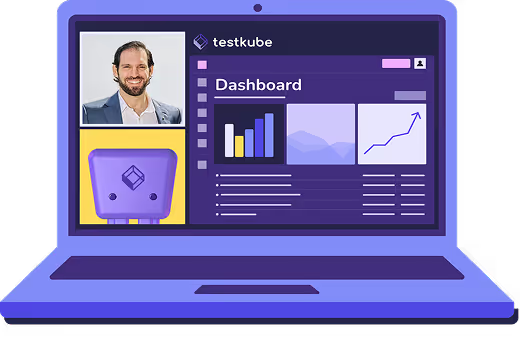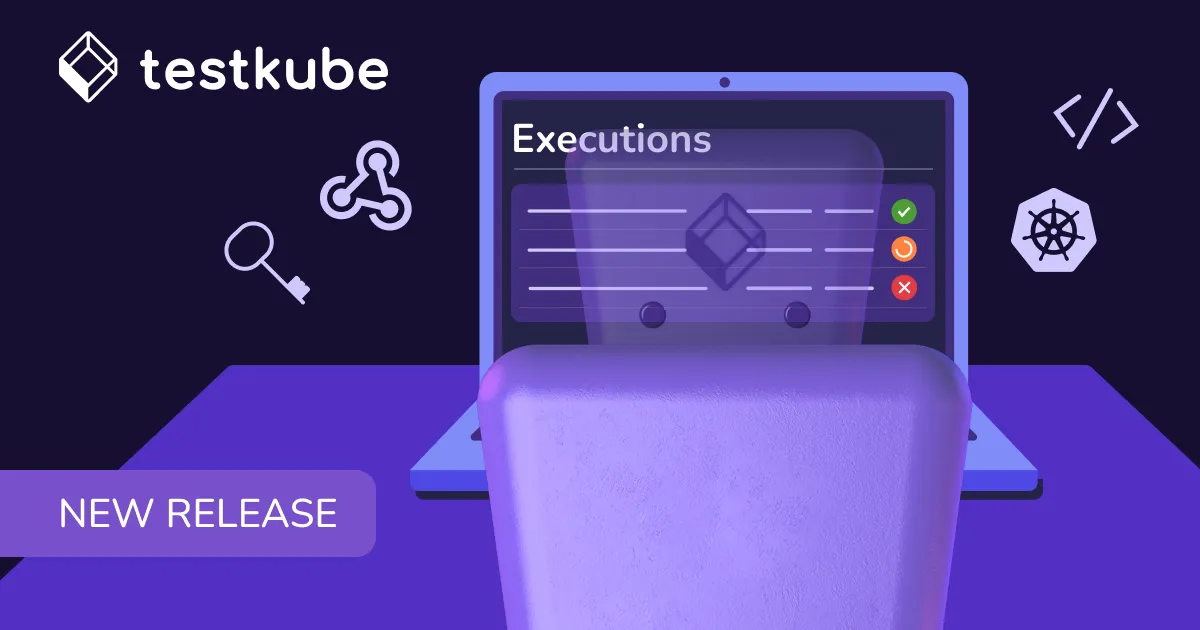Table of Contents
Try Testkube instantly in our sandbox. No setup needed.
Try Testkube instantly in our sandbox. No setup needed.




Table of Contents
Executive Summary
Understanding DORA and Digital Operational Resilience
The Digital Operational Resilience Act (DORA) is more than just another compliance checklist—it's a call to action for financial services to rethink how they test and validate their digital systems.
From resilience under stress to regulatory traceability, DORA sets a high bar. And if your workloads run in Kubernetes, meeting those expectations can't rely on traditional, slow-moving testing workflows.
DORA represents a comprehensive regulatory framework for financial institutions operating in the EU. It focuses on ensuring that banks, insurance companies, investment firms, and payment institutions can withstand, respond to, and recover from ICT-related disruptions and threats.
TL;DR
Testkube helps financial services comply with DORA by delivering:
- Continuous resilience testing, disaster recovery test, cyber threats testing
- Full audit trails
- Integrated security and risk validation
- Recovery verification after incidents
- Kubernetes-native execution for speed and security
Whether you're modernizing legacy systems or scaling your cloud-native infrastructure, Testkube provides the testing backbone for secure, auditable, and resilient operations.
The Challenge: Traditional Testing and Modern Infrastructure
Many financial platforms are migrating to Kubernetes, but legacy test frameworks struggle in this environment. Traditional testing approaches often face challenges with speed, scalability, and integration with modern DevOps workflows.
Testkube helps teams build DORA compliance into the software delivery process with Kubernetes-native testing that's secure, scalable, and fully auditable up to critical ICT third party standards.
Here's how.
1. Continuous Testing for Operational Resilience
DORA requires financial institutions to validate the resilience of critical systems regularly—across functional, security, integration, and failure scenarios. The term evolving around this is 'party risk management' relating to planning risk assessments.
Why Continuous Testing Matters
Digital operational resilience testing under DORA goes beyond basic functionality checks. Financial institutions must demonstrate that their systems can withstand and recover from adverse scenarios including cyberattacks, system failures, and service disruptions.
This requires comprehensive testing across multiple dimensions:
- Functional testing to verify core capabilities
- Performance testing under various load conditions
- Security testing to identify vulnerabilities
- Failover testing to ensure backup systems work correctly
- Recovery testing to validate restoration procedures
- Integration testing between connected systems
What this means for platform teams: testing needs to be continuous, automated, and built into the infrastructure.
How Testkube Supports Continuous Testing
Multi-environment testing: Run environment-specific test suites for dev, staging, and production—all orchestrated through Kubernetes.
Shift-left ready: Developers can trigger tests directly using kubectl, the CLI, or API, getting feedback earlier.
Resilience & stress tests: Schedule load, performance, and failover tests to simulate adverse conditions.
Post-incident validation: Automatically trigger recovery test suites to confirm service stability after outages or rollbacks from backup systems.
[Developer Commit]
|
v
[CI/CD Pipeline]
|
v
[Testkube Trigger]
|
+--> [Functional Tests (Dev)]
+--> [Performance Tests (Staging)]
+--> [Failover Tests (Prod)]
|
v
[Test Results to Observability Stack (Grafana/Prometheus)]
With Testkube, platform engineering teams can schedule regular resilience tests, trigger tests on deployment events, and validate systems throughout their lifecycle rather than at single points in time.
2. Built-in Auditability and Traceability
DORA expects all testing activity to be traceable. That means logs, test results, timelines, and action history must be readily available for internal reviews or external audits.
The Importance of Audit Trails
Regulatory audits require financial institutions to demonstrate precisely what was tested, when, who initiated tests, what the results were, and what actions were taken. This level of detail is essential for proving compliance and supporting incident investigations.
Complete audit trails also enable root cause analysis, support change management processes, and facilitate compliance reporting to supervisory authorities.
How Testkube Provides Traceability
Immutable test logs: Every test run is recorded with full metadata—timestamps, test source, environment, and results.
GitOps-native definitions: Store and version test definitions in Git to track every change.
Trigger history: Monitor which events (e.g., deployments, image changes) triggered which tests.
Centralized reporting: Push logs and results to Grafana, Prometheus, GCP Monitoring, or any observability platform.
[Test Definition (Git)]
|
[Trigger: ArgoCD deploy / PR merge / ConfigMap update]
|
[Test Execution Pod]
|
+--------------------------+
| Metadata: |
| - Test ID |
| - Timestamp |
| - Trigger Event |
| - Environment |
| - Result |
+--------------------------+
|
[Logs & Results stored → Prometheus / Elastic / Graphana / GCP Monitoring]
All of this makes it easy to prove what was tested, when, and why—without adding manual tracking or audit overhead.
GitOps principles align naturally with DORA's traceability requirements. By storing test definitions as code in Git repositories, you gain version control, change attribution, rollback capabilities, and peer review processes—all essential for compliance documentation.
3. Integrated Security & Risk Testing
Security and risk validation aren't optional under DORA. Tests must account for vulnerabilities, misconfigurations, and data integrity risks across your digital estate.
DORA's Security Testing Focus
DORA mandates comprehensive security testing including vulnerability assessments, penetration testing, and scenario-based testing. Financial institutions must identify security weaknesses before they can be exploited.
Key areas include:
- Vulnerability scanning of containers and dependencies
- Configuration validation to prevent misconfigurations
- API security testing
- Authentication and authorization verification
- Data protection validation
How Testkube Integrates Security Testing
Plug into your security stack: Run tools like Trivy, OWASP ZAP, or custom bash/python scripts to check for CVEs, API misbehavior, or insecure defaults.
Policy testing: Automatically detect misconfigured RBAC, network policies, and insecure services.
CI/CD test gates: Block risky releases by embedding security checks directly in your delivery pipelines.
[CI Job]
|
+---> [Build Image]
|
+---> [Run Trivy Scan via Testkube]
| |
| +-- Pass --> Proceed
| +-- Fail --> Block deploy
|
+---> [Run OWASP ZAP Test]
|
+---> [Deploy via ArgoCD]
With Testkube, every change is security-aware—without needing to reinvent your toolchain.
Security testing shouldn't be a final gate before production. Testkube enables integration throughout your software delivery lifecycle by running container scans after image builds, validating Kubernetes manifests against security policies, testing API endpoints for vulnerabilities, and verifying network policies and RBAC configurations.
4. Incident Response and Recovery Validation
DORA emphasizes fast, reliable recovery from ICT incidents—and that includes validating that your fixes actually work.
Why Recovery Validation Matters
DORA requires financial institutions to establish recovery time objectives and recovery point objectives for critical systems. But defining these objectives isn't enough—organizations must regularly test their ability to achieve them and maintain documented evidence.
Effective recovery validation includes backup restoration testing, failover testing, service restoration verification, data integrity checks, and performance validation.
How Testkube Automates Recovery Testing
Run tests post-failure: Trigger targeted health or regression tests as soon as incidents are resolved or rollbacks are applied.
Self-service testing: Developers and SREs can run recovery validation on demand—no pipeline deploy required.
Low-latency feedback: Tests run in-cluster for fast validation, right where your workloads live. This provides close to instant test results.
[Incident Detected → Alertmanager]
|
[Trigger Testkube Recovery Test Suite]
|
+------------------------------+
| - API Health Check |
| - Database Connectivity |
| - Critical Path E2E Test |
+------------------------------+
|
[Test Results to Grafana + Slack Alert]
Recovery testing should be automatic, not an afterthought. Testkube makes it part of the operational workflow.
Manual recovery validation introduces delays when systems need to be restored quickly. Testkube automates this by detecting incident resolution, automatically triggering health check suites, validating critical paths, checking data consistency, and notifying stakeholders through your existing communication channels.
5. Reporting for Regulatory Oversight
Supervisory authorities want more than summaries. They expect full visibility into how testing is managed—and proof that your systems are being validated correctly.
Meeting Reporting Requirements
DORA mandates detailed reporting to supervisory authorities including periodic assessments of operational resilience and documentation of testing activities. These reports must be comprehensive, accurate, and readily available.
Effective compliance reporting requires test coverage metrics, trend analysis, incident correlation, and policy compliance evidence.
How Testkube Enables Compliance Reporting
Exportable execution history: Generate and share logs, results, and artifacts as part of your regulatory documentation.
Observability integrations: Feed data into your compliance dashboards (Grafana, GCP Monitoring, Datadog, etc.).
Policy-as-code: Define testing policies as CRDs and enforce them at every stage of the pipeline.
You get compliance visibility without needing to stitch together tooling from scratch.
Testkube's integration capabilities enable you to build compliance dashboards that provide real-time visibility into testing activities. By feeding test data into your observability stack, you can track testing coverage, monitor test success rates, visualize compliance metrics, generate automated reports, and provide executive visibility.
Why Kubernetes-Native Testing is Key to DORA
Most financial platforms are migrating to Kubernetes—but legacy test frameworks aren't built for this world. They're slow to adapt, hard to scale, and tricky to secure.
The Kubernetes Advantage
Kubernetes has become widely adopted for deploying containerized applications in financial services, offering improved resource utilization, enhanced scalability, and simplified deployment processes. However, these advantages require testing strategies that align with cloud-native infrastructure.
Kubernetes-native testing means tests run where applications run, eliminating environment inconsistencies. Scaling matches workload patterns, security models align with existing RBAC and network policies, and GitOps compatibility enables declarative configurations.
Testkube's Kubernetes-Native Architecture
Testkube is purpose-built for Kubernetes, which means:
- Tests run in-cluster, close to your workloads
- Native RBAC and namespace support for team and service boundaries
- GitOps-compatible, declarative configuration
- Full test orchestration across any tool, written in any language
This isn't just about passing audits—it's about building a testing platform that scales with your infrastructure and enforces resilience by default.
In-Cluster Execution: Tests run inside the same Kubernetes clusters as your applications, eliminating network latency and environmental differences that affect external testing tools.
Native RBAC Integration: Testkube leverages Kubernetes Role-Based Access Control to enforce testing permissions, ensuring only authorized users can execute tests against production systems.
Namespace Isolation: Multi-tenant testing environments are naturally supported through Kubernetes namespaces, allowing teams to work independently while maintaining security boundaries.
Custom Resource Definitions: Test configurations are defined as Kubernetes CRDs, meaning they're versioned, validated, and managed through the same GitOps workflows as your infrastructure.
Workload Portability: Because Testkube runs anywhere Kubernetes runs, your testing strategy works identically across on-premises data centers, public clouds, and hybrid environments.
Getting Started with Testkube
Here's how to begin building DORA-aligned testing with Testkube:
Implementation Steps
1. Deploy Testkube in your QA, staging, and production clusters
Install Testkube using Helm or the Testkube CLI, configure RBAC permissions, set up namespace isolation, and integrate with your authentication systems.
2. Define test CRDs for your critical services (e.g., trading APIs, payment flows, authentication systems)
Identify systems classified as critical under DORA, create test definitions covering functional, security, and resilience scenarios, and store test configurations in Git repositories.
3. Integrate with your CI/CD tool of choice—GitHub Actions, Jenkins, ArgoCD
Configure webhook triggers from your deployment pipelines, set up automated test execution on merge requests, implement test gates, and create rollback procedures.
4. Export test results to your monitoring and compliance dashboards
Configure integrations with Grafana, Prometheus, or your observability platform, create dashboards visualizing test coverage and success rates, and set up alerts for test failures.
5. Track test data in the context of incidents, deployments, and environment health
Correlate test failures with incident timelines, analyze patterns in results, and use test data to inform capacity planning and architecture decisions.
Contact us for a personalized demo or Proof of Concept conversation
Our team can help you assess your current testing approach, design a testing strategy aligned with your systems, and implement Testkube with best practices.
Final Thoughts
DORA compliance doesn't have to be slow or complex. With Testkube, financial institutions can operationalize resilience testing directly in Kubernetes—automated, secure, and always audit-ready.
Whether you're migrating off legacy systems or already running cloud-native infrastructure, Testkube gives your team the testing control plane needed to stay compliant and resilient.
Beyond regulatory compliance, Testkube can help deliver business value through faster testing feedback loops, improved system reliability through continuous validation, better security posture with automated vulnerability detection, and greater confidence in deployments.
👉 Learn how other regulated real world teams are using Testkube at testkube.io


About Testkube
Testkube is a cloud-native continuous testing platform for Kubernetes. It runs tests directly in your clusters, works with any CI/CD system, and supports every testing tool your team uses. By removing CI/CD bottlenecks, Testkube helps teams ship faster with confidence.
Explore the sandbox to see Testkube in action.






